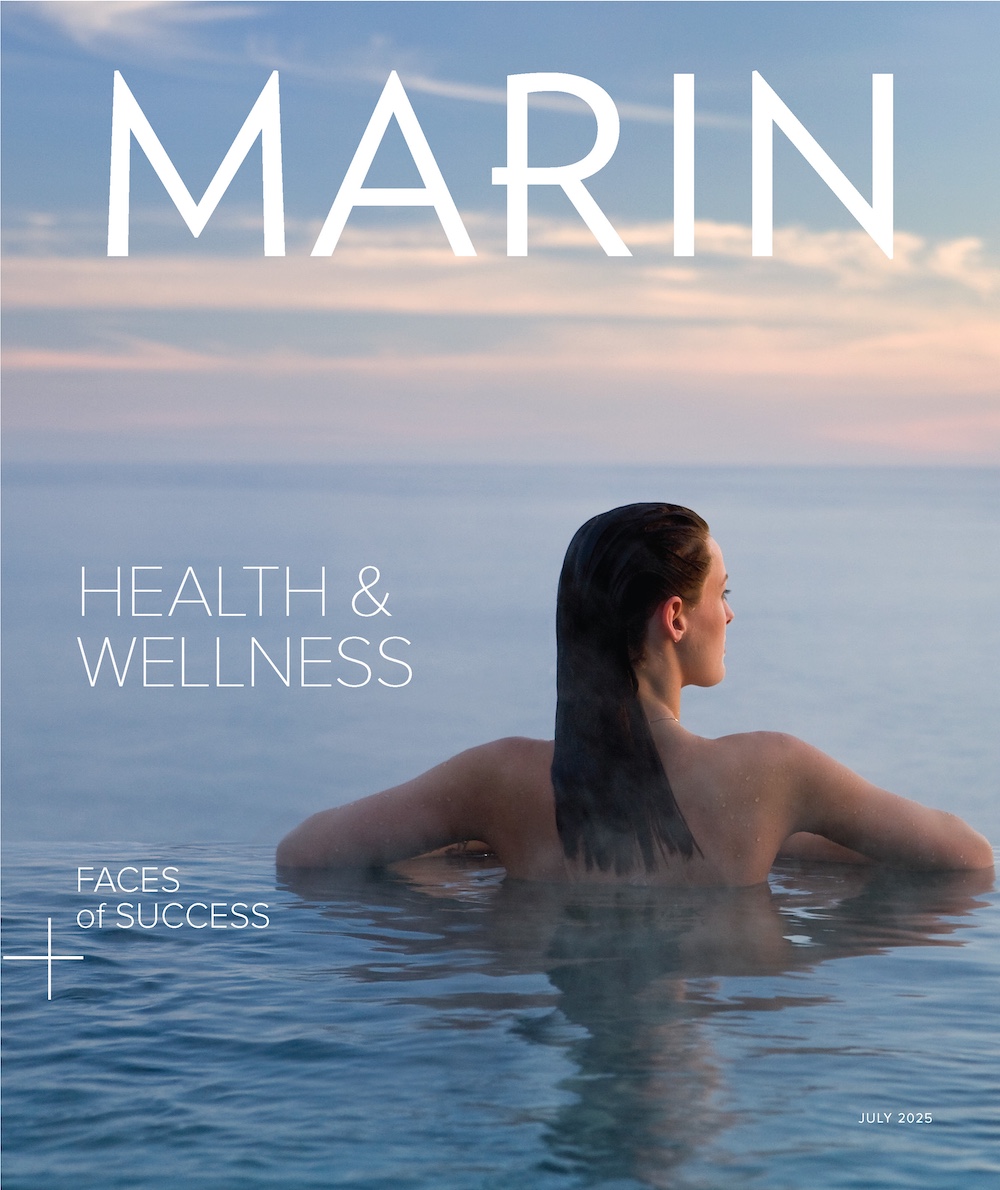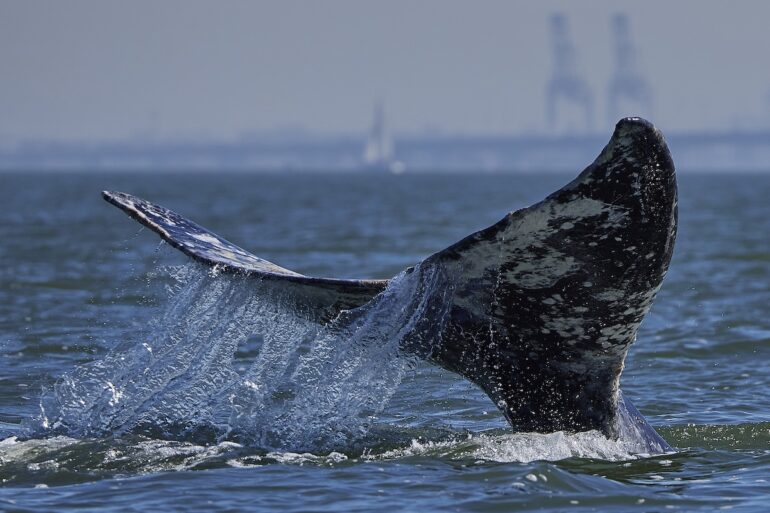With binoculars steady in hand, Darrin Allen scans the vibrant waters where San Francisco Bay meets the Pacific. From his lookout at Battery Yates on Cavallo Point’s Yellow Bluff, he peers between the rocky silhouette of Alcatraz and the fog-laced green slopes of Angel Island rising to the left. Behind him, the rust-red North Tower of the Golden Gate Bridge pierces the sky.
On this gusty, golden-lit Saturday — March 22, 2025 — the Bay is bustling with spring energy. Perched atop the coastal bluffs at Battery Yates, Allen has a commanding view of the dynamic ballet of marine traffic: sleek kayakers, high-speed ferries and colossal cargo ships slicing toward port. But Allen isn’t watching for vessels — he’s scanning for something far more vulnerable: gray whales. Their northbound migration from Baja’s whale nurseries has arrived early this year, overlapping with one of the busiest weekends on the water.
“There are about six grays in the Bay right now,” says Allen, a retired Marin firefighter and volunteer whale spotter with the Marine Mammal Center. Tall, easygoing and composed, Allen now spends many of his retirement days aboard a boat, scanning for the telltale V-shaped exhale of a whale. Today, he’s behind a tripod-mounted camera, pointing toward two distant misty plumes past Alcatraz several miles offshore. “Two blows,” he says quietly. One pair, he notes with concern, is drifting into the high-speed ferry corridor; the other, perilously close to the cargo shipping lane. “Those aren’t safe places for them to be.”
On this particular morning, SailGP’s foiling catamarans skim like flying blades across the Bay off the St. Francis Yacht Club. From shore and support vessels, trained observers with the race’s marine mammal program log whale positions in real time to help avoid tragic collisions — a precaution born of necessity in these shared, increasingly crowded waters.
“Sometimes they dive for 20 minutes and pop up a mile away,” Allen explains. Mornings, he notes, offer better odds for spotting whales: calmer seas make their spouts easier to see and movements more predictable. Sailors, by contrast, chase the wind — and prefer the punchier breezes of afternoon.
Still, even with vigilant eyes on the water to protect these gentle giants, by April the headlines began to darken: another dead whale washed ashore. The joy of a sighting gave way to grief, a necropsy and public outcry. By June 1, the California Academy of Sciences had documented 15 whale deaths in the San Francisco Bay Area alone — a sobering toll that underscores the mounting threats these giants face on their long migration.
What’s driving the change? In many cases, it’s the growing impact of ship traffic. Other times, it’s deeper stressors — warming seas, vanishing prey or disorientation amid an increasingly chaotic soundscape of thunderous propellers, seismic blasts and low-frequency sonar pulses. Not every necropsy confirms a ship strike, but each loss deepens the urgency. These returning giants are proof that conservation can work — yet their vulnerability is a stark reminder of how fragile that success still is.
A Remarkable Recovery with New Challenges
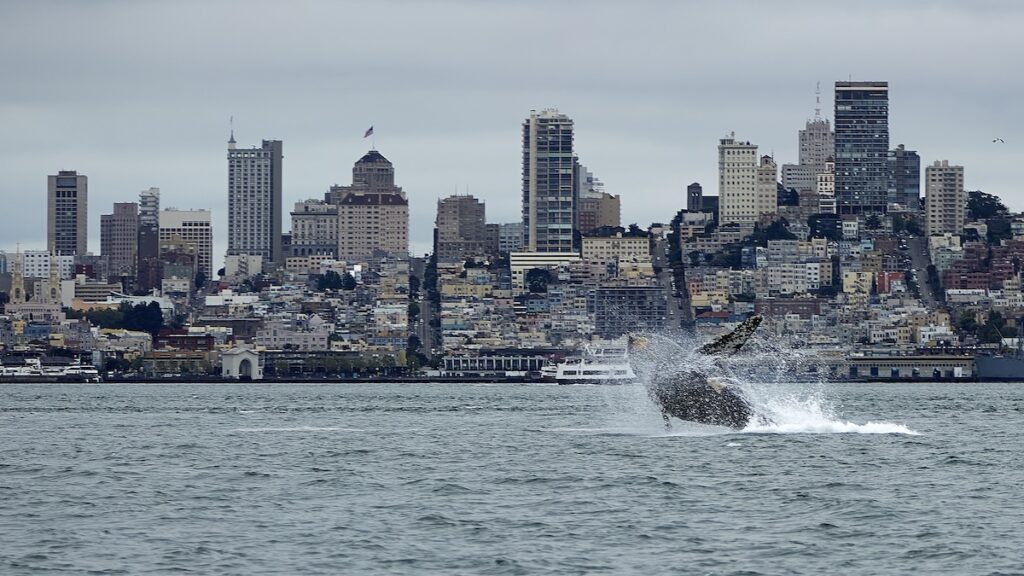
San Francisco Bay’s ecological renaissance tells a powerful story of resilience. Decades of dedicated water quality improvements have brought back species once entirely absent since World War II — like harbor porpoises, now regularly seen feeding along the tidelines. More recently, even larger marine mammals have begun lingering longer in the Bay, including seasonal visitors like gray whales, while humpbacks can be spotted year-round in local waters.
These gentle giants captivate residents and visitors alike. When anchovies flood into the Bay, it’s hard not to be spellbound by the sight of a dark gray humpback erupting from the surface — its 60-foot, 40-ton body breaching skyward, long white pectoral fins flared, pleated belly catching the light — before crashing down in a thunderous splash just beyond the Golden Gate, near Kirby Cove. Elsewhere, a 30-foot gray whale glides past the Sausalito docks, its barnacle-crusted back mottled like granite. Unlike the humpback, the gray whale has no dorsal fin — revealing only a gentle hump before it lifts its broad fluke and dives to sift through the muddy seafloor in search of benthic crustaceans. These encounters stir awe, connection and concern. As more whales return to these increasingly crowded waters — shared with commercial ships, fishing vessels and recreational boaters — the question becomes urgent: How do we protect them?
While the San Francisco Bay Area is one of the world’s busiest urban estuaries, it’s also home to a robust community of informed citizens and collaborative changemakers dedicated to protecting it. The Marine Mammal Center in Sausalito — long a sentinel for observation, rescue, and rehabilitation — is now tackling a more complex challenge alongside its partners: informing science-based solutions that bridge conservation and industry to keep whales safe. Their success across the Bay — including implementing real-time whale tracking systems and supporting voluntary vessel speed reductions — is helping reduce fatal ship strikes. That local momentum, along with related work in offshore sanctuaries like Greater Farallones and Cordell Bank and through the International Whaling Commission, is building a global model for mitigating marine mammal risk in increasingly trafficked coastal waters.
Understanding Changing Migration Patterns
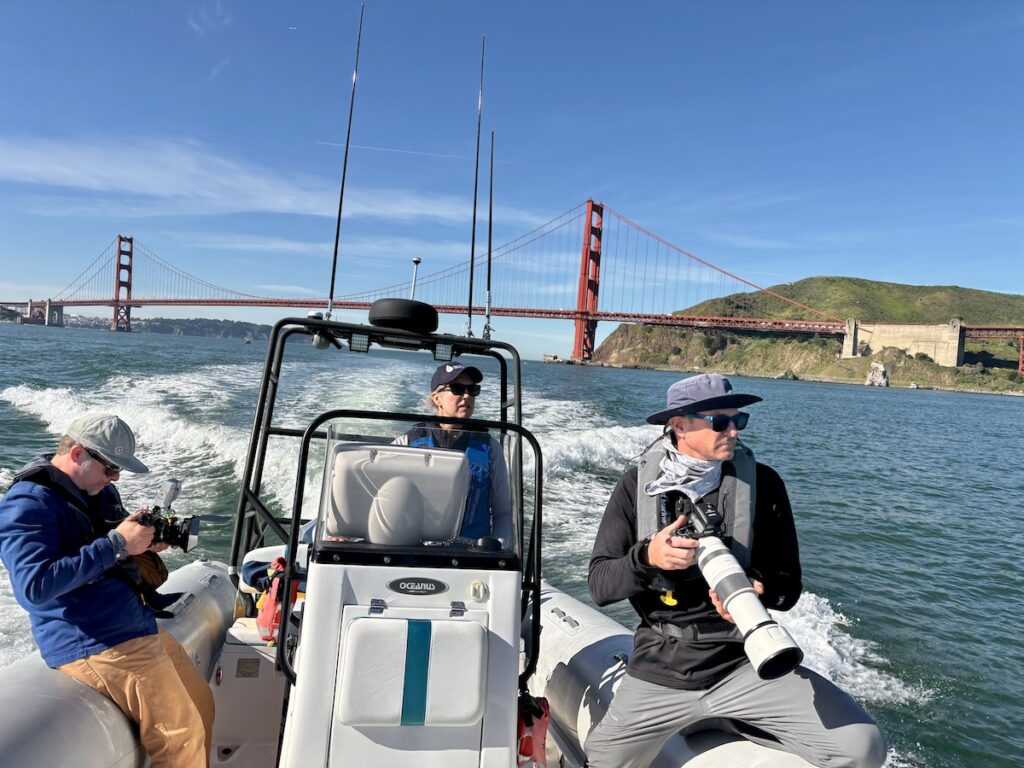
Gray whales are known for their epic 10,000-mile migrations from Baja’s warm lagoons — winter breeding grounds — to the frigid Bering Sea, where they feed in summer. But in recent years, some grays have lingered unusually long in coastal bays during their northbound journeys.
“This kind of behavior could be a sign of distress,” explains Allen, who photographs individual whales for the Marine Mammal Center’s identification database. Since 2019, more than 45% of the Eastern Pacific gray whale population is estimated to have died. “They’re arriving emaciated, covered in lice. This makes them vulnerable to disease. The Bay might be a good place for them to rest and feed.”
Oceanographers link this die-off to climate-driven disruptions in Bering Sea productivity. With less sea ice, food supplies like tube worms and other bottom-dwelling invertebrates are disappearing, leaving whales starving in what were once reliable feeding grounds.
Meanwhile, the behavior of local endangered humpbacks is also shifting, as warming seas and changes in prey availability disrupt their historic migration routes. Farther offshore, endangered fin whales and blue whales — the largest animals ever to live — are adjusting their foraging patterns in response to changing upwelling zones in the Northern California Current. These nutrient-rich waters fuel blooms of krill, the tiny crustaceans that sustain these giants. A single blue whale, nearly 100 feet long and weighing up to 200 tons, can consume up to 16 tons of krill a day — strained through massive baleen plates.
But as prey shifts closer to shore or sanctuaries, so do the whales — bringing them perilously close to human activity, namely, ship traffic and fishing gear.
Few people understand the stakes better than Kathi George. A veteran diver with six whale disentanglements to her name, George has spent the past decade on the front lines of cetacean rescue. As Director of Cetacean Conservation Biology at the Marine Mammal Center, she collaborates with scientists, captains and policymakers to reduce human-wildlife conflict in coastal waters. She puts it plainly: “Human activity in whale habitats is on the rise, and whales are increasingly present in busy urban waterways. This growing overlap calls for proactive adaptation.”
Deadly Intersections
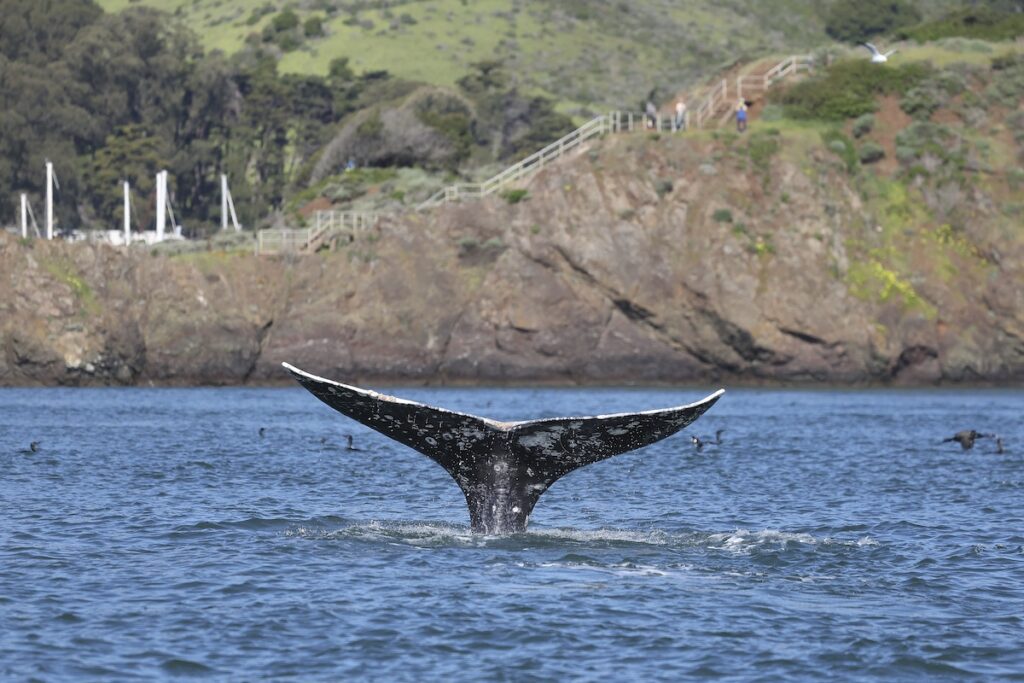
California’s coast holds two primary feeding corridors for whales: one stretching from San Francisco and the Farallones down to Monterey Bay, the other from Santa Barbara to the Channel Islands. Dubbed by the International Whaling Commission (IWC) as “ship strike hot spots,” these critical feeding zones lie in the highest density of commercial maritime traffic in the world, overlapping with the highest abundance of migrating and feeding whales.
“Ship strikes often occur due to high vessel speed when cetaceans aren’t aware or able to react fast enough to approaching ships,” explains George. “Whale presence may not be noticed due to whale behavior, poor visibility, darkness, weather conditions, missing lookout on board or lack of communication about whale sightings between vessels.”
The statistics are sobering. Six endangered whale populations migrate through the Greater Farallones and Cordell Bank sanctuaries. Yet three major shipping lanes cut directly through these vital feeding grounds, leading to and from the Port of Oakland, the eighth busiest port in the United States. Modeled numbers from Rockwood et al. (2017) suggest that in a single recent year, ship strikes on the U.S. West Coast killed 18 blue whales, 22 humpbacks and 43 fin whales. Most carcasses sink without being detected. In fact, only an estimated 2% to 17% of fatal strikes are ever documented.
Globally, the toll is even more alarming: up to 20,000 whales may be killed by ships each year.
Today, approximately 90% of global goods travel by sea, with maritime trade projected to double by 2050 — potentially tripling carbon emissions. These emissions contribute to climate change, which in turn intensifies threats to whales by melting Arctic ice and opening new shipping routes through critical feeding grounds. According to a recent study in Science, 15% of the world’s oceans now face ship-strike risks comparable to the California Current Ecosystem. Critical hot spots exist in places like Sri Lanka, Ecuador, the Canary Islands (Spain) and the Hellenic Trench (Greece) for endangered sperm whales, the Northwest Mediterranean Sea for endangered fin whales and the Northeast coast of the US, where North Atlantic right whales are on the brink of extinction.
In 2008, the National Oceanic and Atmospheric Administration (NOAA) introduced the Vessel Speed Rule, later strengthened by additional amendments in 2020. Yet, persuading shipping vessels and companies to cooperate in consistently slowing down has proven challenging.
“Slowing to 10 knots reduces fatal collision risk,” explains George. “It also cuts emissions and ocean noise. Everyone wins — the whales, the environment, and ultimately the maritime industry through positive public perception.”
Voluntary measures alone aren’t enough. To truly safeguard whales, speed limits must be science-based, enforceable and monitored globally. The stakes — biodiversity, climate stability and industry credibility — are too high to ignore.
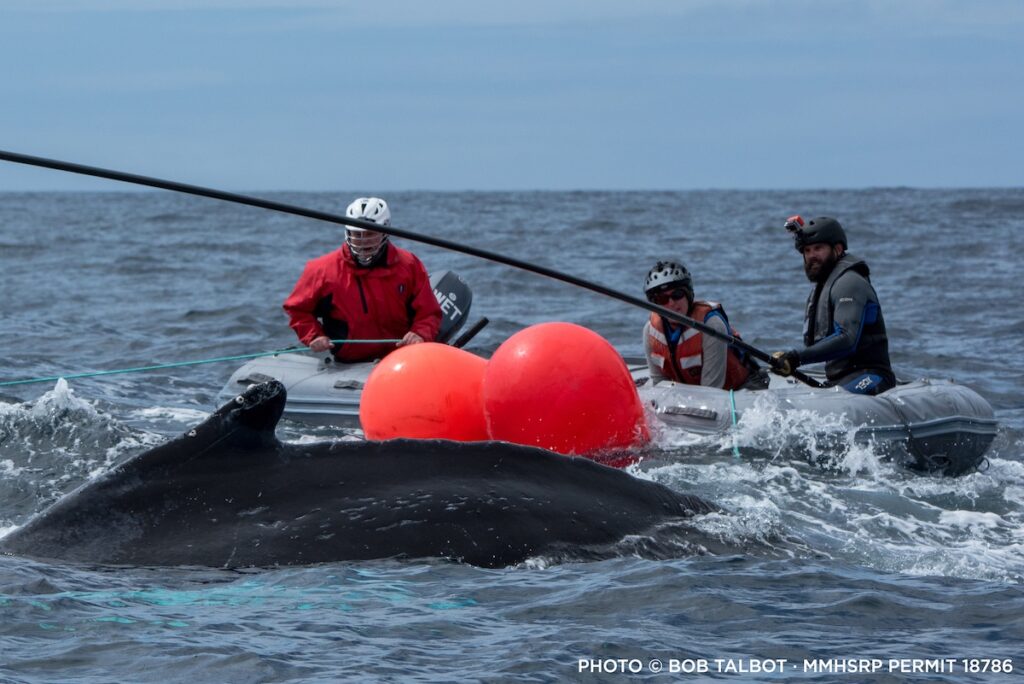
A Tangled Threat
While commercial whaling once decimated whale populations, today’s dangers are more insidious and less visible. Beyond vessel strikes, entanglement in fishing equipment also poses challenges — particularly abandoned “ghost nets” and trap gear along the California coast.
“Between 30 and 70% of whales on the West Coast bear scars from past entanglements,” explains Ryan Berger, wildlife biologist. With 20+ entanglement responses under his belt — including ~10 full and partial releases and three multi-day operations — Berger knows the grim reality up close. “When a whale becomes entangled, that gear can remain attached for days, months, even years, interfering with everything essential to survival — swimming, feeding, breathing.”
The toll is brutal. “I’ve seen whales with entire flukes severed, or pectoral fins that detached during our response,” Berger adds. Severe cases lead to death through infection, starvation, blood loss or suffocation. While some whales manage to shed gear independently, many perish without intervention. “It is important to note that no one wants to see these majestic creatures suffer and work to mitigate this is ongoing.”
Efforts to address whale entanglement took shape in the 1990s, when NOAA formalized marine mammal stranding and disentanglement networks. But the issue came to a head in 2016, when a spike of 70 reported entanglements was reported along the West Coast. This galvanized urgent action from a newly formed working group that unites commercial fishermen, scientists, policymakers and conservationists.
The rescue work is as costly as it is dangerous. “Each disentanglement operation costs approximately $14,000,” notes Berger. “A five-person team might spend several days working to free a whale from a single Dungeness crab pot.”
The risks are substantial. “A 40-ton distressed animal can become frightened or agitated by boats. Their predator-prey instincts kick in — they may lash out with force and threatening blows or vocalizations,” Berger explains. “We’re trained well to manage these situations. First, we extensively document the whale’s behavior and the entangling gear using photos and drone footage. Then we identify one strategic cut where drag force from the whale’s own movement can release the remaining gear.”
Prevention remains the gold standard. “A lot more research is needed, but we’ve made real progress,” says Berger. “We’re conducting research that informs RAMP regulations and management actions in the fishery, inviting fishermen to participate in disentanglement responses and collaborating on other risk reduction efforts.”
One of the strongest voices for industry-led innovation is Richard Ogg, a longtime commercial fisherman and member of the California Dungeness Crab Fishing Gear Working Group since 2017. He’s seen the culture shift firsthand. “It’s great to see these animals making a comeback,” Ogg reflects. “For a long time, fishermen got used to their absence after the whaling era. We’re now creating options that lower the risk to whales without putting fishermen out of business.”
The results speak for themselves. “Last year there were only four confirmed commercial Dungeness crab entanglements,” Ogg notes proudly. “That’s a mitigation win. But it’s hard for people to understand what we’re up against and giving up — our eight-month crabbing season was cut in half.”
And yet, amid the risk and sacrifice, one question lingers: Do whales somehow sense they’re being helped?
Berger pauses to consider. “We can’t know for sure. Humpbacks are highly intelligent. I’ve observed them help each other, and they often inspect us, looking up at our boats during rescues. After one disentanglement, a humpback swam around our vessel three times. Maybe it was disoriented. Maybe it was saying thank you. I like to think they know we’re trying.”
Navigating Solutions Together
Just as fishing gear and seasons have been adapted to protect whales, vessels can reduce speeds to avoid deadly collisions. Yet despite the implementation of Vessel Speed Reduction (VSR) zones and voluntary seasonal guidelines, ship strikes remain disappointingly high. Many shipping companies do participate in these conservation measures, but the lack of enforceable mandates creates competitive disadvantages — those who comply often fall behind companies that prioritize speed.
Whale Safe, a real-time monitoring system developed by the Benioff Ocean Science Laboratory (BOSL) at the University of California, integrates acoustic data, visual sightings and AI-powered ship tracking to monitor both whales and vessels. It generates “report cards” grading shipping companies from A+ to F based on their cooperation with speed recommendations across North America. While some companies, like MSC, Maersk, Hapag Lloyd, Ocean Network Express and NYK Line consistently score high, not all operators are willing to slow down without mandatory requirements.
“Since whales are now present year-round off San Francisco, there’s strong reason to support year-round speed reductions,” says George. “The most effective strategies involve working directly with maritime professionals who want to be part of the change.”
Although several top-rated shipping companies declined to comment, others in the harbor community are eager to collaborate. Tony Heeter, Operations Supervisor at Blue & Gold Fleet and Vice-Chair of the San Francisco Harbor Safety Committee, highlights the value of coordination between scientists and industry. “The hazards are dynamic, and the presence of gray whales has everyone on high alert,” he says. “San Francisco Vessel Traffic Service (Channel 14) does an outstanding job keeping operators informed. By calling in, we get real-time updates on whale locations and other hazards, allowing us to alter course in advance.” Heeter also urges recreational boaters to tune in and report whale sightings via the Whale Alert app. As Blue & Gold transitions to electric vessels and Golden Gate Ferry adopts hybrid technology, he sees evolving protocols as key to helping whales detect vessels — supporting both safety and sustainability.
Offshore, Whale Safe provides a real-time whale presence rating to improve situational awareness for mariners. The initiative is powered by a collaboration of leading institutions: The Marine Mammal Center; Point Blue Conservation Science, which monitors wildlife around the Farallon Islands and offshore waters; the Benioff Ocean Science Laboratory, which developed Whale Safe; Cascadia Research Collective, experts in North Pacific cetaceans; Woods Hole Oceanographic Institution and the Norwegian University of Science and Technology, both contributing to acoustic detection and validation; and NOAA, which provides a blue whale habitat model. Together, these partners are creating a dynamic, live map of whale activity — empowering safer navigation and helping reduce fatal ship strikes.
As more shipping companies begin incorporating Whale Safe grades into their sustainability reporting, the potential to scale acoustic buoy networks and monitor vessel speed reduction (VSR) cooperation is gaining traction across California — and potentially far beyond. The state’s AB 14 “Blue Whales and Blue Skies” legislation may soon standardize these practices statewide — laying the groundwork for broader adoption along the Pacific Coast and internationally. Yet this momentum risks stalling in the face of significant proposed cuts to NOAA’s budget.
“The federal government is essential to advancing this work internationally,” says George. “NOAA plays a central role in our collaboration.”
The proposed fiscal year 2025 NOAA budget includes a nearly 30% reduction — amounting to $1.7 billion less — threatening programs vital to ocean health. The National Marine Sanctuary Program alone is facing a $150 million cut, according to the agency’s own budget summary. “Without adequate funding, key partners like Point Blue have already had to cut some of their operations,” George adds.
A Hopeful Future
Despite mounting challenges, the future of whale conservation remains promising — powered by innovation and collaboration. Acoustic buoys used in the Whale Safe system already detect whale presence, and new models will soon track their direction of travel. This data can be combined with infrared detectors on the Golden Gate Bridge, drone surveys, tagging, hydrophone arrays, and 3D forward-looking sonar to help vessels avoid whales in real time. In the long run, artificial intelligence may improve the detection and interpretation of whale vocalizations — identifying patterns, distinguishing species and alerting mariners to nearby presence with greater precision.
“Effective reduction of vessel strike risk depends on strong collaboration with industry. Transparent information sharing and responsive action are critical to protecting whales.”
Everyone on the water has a role — mariners, kayakers, yacht owners and fishers. George urges using the Whale Alert app to log sightings and report whales to the Coast Guard’s Vessel Traffic Service on Channel 14.
“We’ve created a model other busy ports can follow,” says George. “Seeing a whale in the Bay reflects decades of restoration and conservation. Reporting one can save lives.”
As federal support declines, public involvement is more vital than ever. Groups like The Marine Mammal Center and Point Blue depend on community support to continue this critical work. Whether by giving time, sharing sightings or donating resources, Bay Area residents can help keep local waters safe — and ensure whales remain part of them for generations to come.
